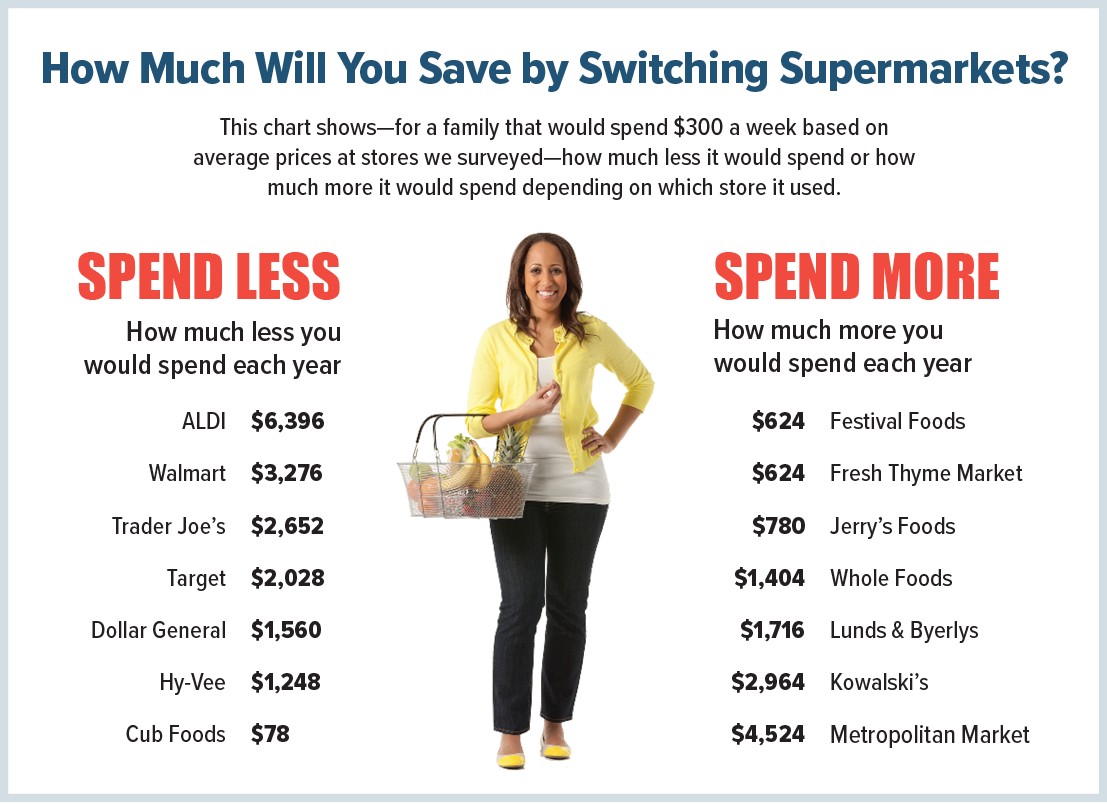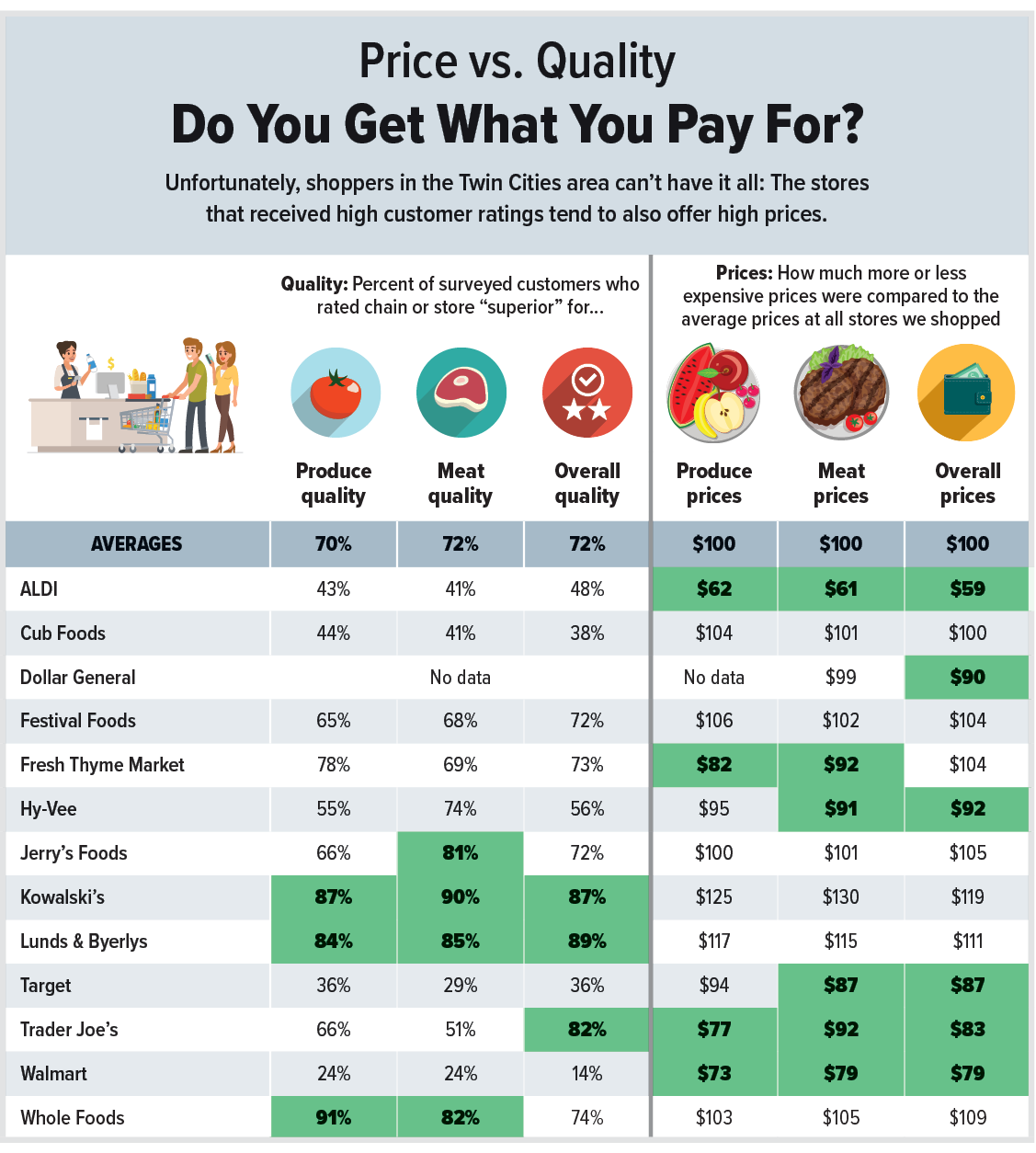Which Grocery Stores Offer the Best Prices and Quality?
Last updated November 2025

Our latest comparison of Twin Cities area supermarkets’ prices and quality is in the bag. Consumers’ Checkbook researchers shopped stores using a 150-item list to compare prices. To evaluate stores on quality of products and service, we surveyed our members. The figures below summarize our findings; for details, see our Ratings Tables. Here’s what we found:
ALDI offers the biggest savings.
The German-based discounter, ubiquitous in most of western Europe, focuses on low costs, and our survey found ALDI quite inexpensive: For our shopping list, its prices were 41 percent lower than the all-store average. ALDI’s per-unit prices were even lower than Costco and Sam’s Club.
These savings are partly explained by ALDI’s smaller-format stores, which have much lower overhead costs than conventional supermarkets.
ALDI also benefits from different expectations. Shoppers at Cub, Hy-Vee, Walmart, etc., expect to always find their favorite brands on the shelves. Like Trader Joe’s, ALDI carries mostly its own brands, not national-brand products. ALDI does offer some national brands, but overall, selection is limited. In other words, you’ll find some of the most popular brands (Coke, Heinz ketchup, Hellmann’s mayo, etc.) at ALDI, but probably only in one size.
Instead, ALDI’s shoppers trade that quirkiness for comparable very-low-priced products. (To account for brand differences, we used a modified market basket to compare ALDI and Trader Joe’s prices with conventional supermarkets; click here for more info.)
Other price standouts: Walmart and Target.
Walmart offered prices about 21 percent lower than the average at all other stores we surveyed. Target had prices about 13 percent lower than the all-store average.
For a family that spends $300 per week at the supermarket, a 21 percent price difference totals savings of $3,276 per year; a 13 percent price difference totals $2,028 a year.

Trader Joe’s remains popular and is inexpensive.
Eighty-two percent of survey respondents rated the funky-and-fun chain “superior” for “overall quality.” It’s also now a price leader in the area: TJ’s prices were about 17 percent lower than the all-store average.
Kowalski’s Markets and Lunds & Byerlys continue to earn astonishingly high ratings for quality—but charge steep prices.
Both local chains were rated quite favorably by their surveyed customers overall and for their produce and meat quality. But Kowalski’s prices were the highest among stores we surveyed—19 percent higher than the all-store average—and Lunds & Byerlys’ prices were about 11 percent higher than average.
Compared to Cub, Hy-Vee offers lower prices and better quality.
Hy-Vee’s prices averaged about eight percent lower than Cub’s, and 56 percent of its surveyed customers rated it “superior” overall, compared to only 38 percent for Cub.
Fresh Thyme is no longer an overall price leader, but its produce quality continues to impress.
In our last price survey, Fresh Thyme, a Midwest chain that describes itself as “offering fresh and healthy food at amazing values,” had prices that were, overall, nearly as low as Walmart. But in our latest round of shopping, its prices were about four percent higher than the all-store average. Fresh Thyme did have low prices for produce (18 percent lower than the all-store average) and meat (eight percent lower) but charged very high prices for the brand-name nonperishable items on our shopping list.
Fresh Thyme continues to receive generally favorable ratings for quality, with 73 percent of its surveyed customers rating it “superior” overall.

Whole Foods remains an expensive choice.
When Amazon purchased Whole Foods in 2017, many experts predicted the combination would punish its supermarket competition by combining Whole Foods’ solid reputation with Amazon’s pursuit of distribution perfection. Many consumers hoped they’d pay Amazon-like prices for Whole Foods-quality products. That hasn’t materialized.
Whole Foods built a loyal following by offering high-quality produce, meat, prepared foods, and generic staples. It continues to receive high marks in our surveys of consumers for produce and meat quality, but our price survey found that Whole Foods remains an expensive choice among stores we shopped: Its overall prices were about nine percent higher than the average prices at all stores we surveyed, or about 18 percent higher than Hy-Vee and 38 percent higher than Walmart.
Cub, Target, and Walmart received dreadful ratings for quality.
Walmart was rated “superior” for “overall quality” by only 14 percent of its surveyed customers, Target by 36 percent, and Cub by 38 percent.
Within the largest chains, there is relatively little store-to-store price variation.
Prices at the Cub, Hy-Vee, and Target locations we surveyed were about the same from store to store.
A handful of specialty stores receive raves.
Along with Kowalski’s and Lunds & Byerlys, Almsted’s Fresh Market and several local co-ops ranked best for quality. The co-ops were all rated “superior” by 90 percent or more of their customers for fresh produce.
We also checked out warehouse clubs, looked at unique stores Trader Joe’s and ALDI, and examined grocery delivery options.
Check out the other articles in our “Grocery Stores” category and our ratings tables for info on all the local grocery options, how we rated them, and tips on saving no matter where you shop.


